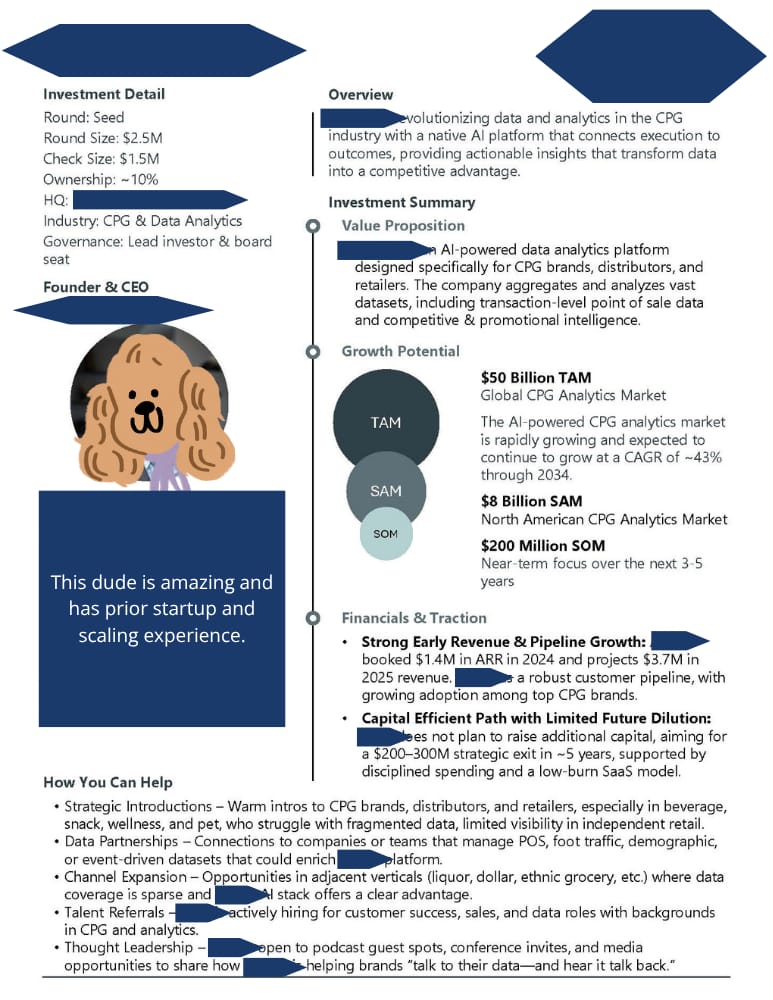Hey, it’s Nick.
In this week’s issue:
How to read an executive summary like a detective
97% of people surveyed are putting off company updates
Check out my baller comment I received after a call
Don’t forget to listen to the deep dive. I’m shooting for 12 minutes at 1.25x
Thank you for checking in this week. Drop any requests to me at [email protected]
Table of Contents
Opening
Sentry Insurance C-Suite Stress Index reveals 97% of business leaders admit their company has put off updates due to cost pressures or scarce resources.
While adaptability is important, consistently deferring updates and reinvestments can hinder long-term growth and innovation, ultimately leading to poor operations and reduced valuations.
Founder Field Note
Wrapped up a first-time call last week, and received the following message, part of an email. Needless to say, I was blown away and appreciative of his kind words about his experience.
To have that seen—truly seen— after 1 hour of conversation by someone like you means more than I can express. I didn’t feel judged on our call. I felt challenged in the best way: with respect, curiosity, and belief. You brought your whole self, and it gave me permission to do the same. That is a gift.
Deep Dive Framework

One-page executive summary
How to Read Between the Lines Like an Investor
A one-page executive summary says more than most founders realize, if you know what to look for.
Just like a recruiter can spot a job-hopper from a resume or a realtor knows a “charming fixer-upper” means bring a sledgehammer, I approach these summaries like a bloodhound. It’s not about what’s on the page. It’s about what’s missing.
This week, I’m tearing down a pitch from a tech/AI startup in the CPG space. The deck is sharp. The numbers are ambitious. The language is polished. But underneath the sizzle, I’m looking for:
Where strategy and execution aren’t aligned
Where the founder is still holding too much
Where the business sounds ready to scale, but isn’t
Whether you’re a founder, operator, or investor, the ability to spot what’s real (and what’s noise) is a game-changing skill. Let’s dive in.
TL;DR: What You’ll Learn in This Breakdown
The founder is capable but over-involved. He’s an operator trying to lead a scalable tech company. That needs to change.
The positioning is generic. Without clear differentiation, they risk getting absorbed or outpaced.
The growth plan is ambitious but fragile. Hitting a 100x exit without raising capital puts enormous pressure on execution.
Burn is low, but the margin for error is lower. The team needs structure, not just hustle.
Their help requests reveal gaps. Talent, distribution, and GTM are still in formation.
1. The Founder: Strong Operator, But Needs to Shift Roles
The CEO built a gig-enabled execution platform before this, which is a high-pressure, logistics-heavy business model that requires serious grit. That tells me he’s smart, disciplined, and not afraid to get into the weeds.
But this business is different. AI in CPG requires deep data integration, repeatable product development, and strategic partnerships. The founder needs to lead with vision, not task management.
He’s likely still:
Approving big deals
Making key hires
Personally leading go-to-market
This means it’s not yet a scalable business. It’s still founder-led. That’s a problem.
What to do next:
Build a RACI matrix to clarify ownership and decision rights
Transition the founder to a Vision and Growth role only
Launch weekly scorecard reviews to keep him informed, not involved
This founder has the potential to be the company’s greatest asset. But only if he steps into the right seat.
2. Overview & Value Prop: Clean but Commoditizable
The company’s claim? They’re “transforming data and analytics in the CPG industry.”
That sounds fine, until you realize every analytics startup in the last decade has said the same thing. The phrase is overused and under-explained.
So here’s what I’m asking:
What exactly is being transformed?
Is the tech already delivering results, or is that still aspirational?
Who’s actually building it? A team, or just the founder?
Without clarity, this positioning feels more like buzz than backbone. And in a space evolving as fast as AI, generic messaging is dangerous.
Fix the gaps:
Separate what’s already built from what’s still in development
Create a “Feature Readiness Scorecard” to match claims with functionality
Pull anything from your marketing that isn’t live or in beta
You don’t need to sound visionary. You need to sound real.
3. Growth & Exit: Ambition Without Room for Mistakes
The company projects $1.4M ARR in 2024, growing to $3.7M in 2025. They claim they won’t need to raise more capital and still plan to exit for $200M to $300M within five years.
That’s a nearly 100x outcome, all while staying lean. It’s bold, but incredibly fragile.
To hit those numbers, everything has to go right:
The tech needs to scale without breaking
Retention, pricing, and expansion must perform
The founder can’t be the bottleneck anymore
There’s no margin for a misfire.
What to do now:
Back up TAM/SAM/SOM with “Path to 10% Market Share” math
Identify your top 50 ICPs or logos and start building outbound
Stress-test churn. At 3% monthly, the entire model collapses quickly
Big exits don’t come from hype. They come from sustained execution. This plan needs more than optimism; it needs infrastructure.
4. Capital & Burn: Efficient, but Exposed
On paper, their capital strategy looks sharp. No new funding. Modest burn. Scaling from $1.4M to $3.7M ARR.
But if they’re trying to scale fast without capital, they need to hit on every hire, avoid rework, and build systems that can carry the load.
Right now, it’s more likely they’re still:
Over-relying on the founder's decision-making
Struggling to delegate high-leverage activities
Patchworking systems as they go
Immediate priorities:
Audit where the founder is still the glue
Assign 2 to 3 key decisions to other team members
Run a two-week “shadow SOP” test: let others run the show while the founder observes
Lean works when it’s built on systems. Without them, it becomes a drag on growth.
5. Help Requests: A Window into What's Missing
The deck ends with a familiar list: intros, data partnerships, talent referrals, podcast invites.
Most people skim past this. I don’t. These “asks” reveal what the business still lacks.
Here’s what they’re really saying:
GTM isn’t built
Sales and customer success are still forming
They’re relying heavily on founder-led distribution and storytelling
None of that is bad. But it confirms they’re still building, not optimizing.
What to do:
Rank help requests by strategic importance
Focus on one per quarter, and don’t try to solve five things at once
Ask, “If the founder stepped away for 14 days, what would break?” Fix that first
Requests are only helpful when they map to a clear plan. Right now, this is a to-do list. It needs to become a growth strategy.
The Tear Down: How Falcon Insight Partners Helps
This company is at a turning point. The vision is exciting. The team is gritty. However, they’re carrying too much weight on the founder’s shoulders, and the systems aren’t built to support the scale they’re aiming for.
This is precisely where Falcon Insight Partners steps in with the Raptor Route™.
Founder Shift → Self-Ownership
The founder needs to transition from a doer to a strategic leader. Our Self-Ownership phase of the process helps create space, elevate focus, and unlock the long-term potential of their role.
Team Clarity → Business Ownership
Leadership roles need definition. Delegation needs structure. Our Business Ownership pillar helps build a company that can grow without heroics.
Exit Readiness → Legacy Ownership
If the goal is a $200M+ exit, the business must be de-risked, transferable, and attractive. We help founders build toward that, starting now.
Final Thought: Learn to Read the Silence
When reviewing any one-pager, don’t just focus on what’s said. Look for what’s missing:
Who’s doing the real work?
What still depends on the founder?
Are projections backed by systems?
Where’s the pressure, and who’s holding it?
Reading a deck is like listening to jazz. The power is in the pauses. Learn to hear what others miss, and you’ll see the real story every time.
Stay awesome, stay confident, and keep soaring higher!
— Cheering you on, Nick
Ready for more?
1) Follow me on LinkedIn: Nick Strehle
2) Sign up for this newsletter (if someone sent this to you): The Falcon’s View
3) Learn more about the Raptor Route here: Mastering Ownership

